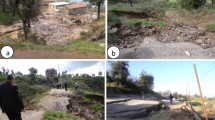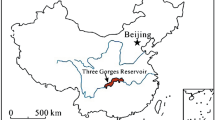Abstract
A colluvial landslide in a debris flow valley is a typical phenomena and is easily influenced by rainfall. The direct destructiveness of this kind of landslide is small, however, if failure occurs the resulting blocking of the channel may lead to a series of magnified secondary hazards. For this reason it is important to investigate the potential response of this type of landslide to rainfall. In the present paper, the Goulingping landslide, one of the colluvial landslides in the Goulingping valley in the middle of the Bailong River catchment in Gansu Province, China, was chosen for the study. Electrical Resistivity Tomography (ERT), Terrestrial Laser Scanning (TLS), together with traditional monitoring methods, were used to monitor changes in water content and the deformation of the landslide caused by rainfall. ERT was used to detect changes in soil water content induced by rainfall. The most significant findings were as follows:(1) the water content in the centralupper part (0~41 m) of the landslide was greater than in the central-front part (41~84 m) and (2) there was a relatively high resistivity zone at depth within the sliding zone. The deformation characteristics at the surface of the landslide were monitored by TLS and the results revealed that rainstorms caused three types of deformation and failure: (1) gully erosion at the slope surface; (2) shallow sliding failure; (3) and slope foot erosion. Subsequent monitoring of continuous changes in pore-water pressure, soil pressure and displacement (using traditional methods) indicated that long duration light rainfall (average 2.22 mm/d) caused the entire landslide to enter a state of creeping deformation at the beginning of the rainy season. Shear-induced dilation occurred for the fast sliding (30.09 mm/d) during the critical failure sub-phase (EF). Pore-water pressure in the sliding zone was affected by rainfall. In addition, the sliding L1 parts of the landslide exerted a discontinuous pressure on the L2 part. Through the monitoring and analysis, we conclude that this kind of landslide may have large deformation at the beginning and the late of the rainy season.
Similar content being viewed by others
Abbreviations
- τ :
-
Shear stress in the sliding zone
- c :
-
Soil cohesion in the sliding zone
- φ :
-
Internal friction angle in the sliding zone
- σ :
-
Total normal stress in the sliding zone
- μ :
-
Pore-water pressure in the sliding zone
- m :
-
Landslide mass per unit area in the sliding surface
- a :
-
Landslide acceleration
- t def :
-
Time scale for deformation of the sliding zone
- t diff :
-
Time scale for pore-water pressure diffusion
- K :
-
Hydraulic conductivity of the sliding zone
- E :
-
Young’s modulus of the sliding zone
- γ w :
-
Unit weight of water
- T :
-
Thickness of the landslide
- v :
-
Velocity
References
Aleotti P (2004) A warning system for rainfall-induced shallow failures. Engineering Geology 73(3):247–265.DOI:10.1016/j.enggeo.2004.01.007
Anderson SA, Sitar N (1995) Analysis of rainfall-induced debris flows. Journal of Geotechnical Engineering 121(7):544–552. DOI: 10.1061/(ASCE)0733-9410
Bai SB, Wang J, Lü GN, et al. (2010) GIS-based and logistic regression for landslide susceptibility mapping of Zhongxian segment in the Three Gorge area,China. Geomorphology 115(1):23–31.DOI:10.1016/j.geomorph.2009.09.025
Baum RL, Johnson AM (1993) Steady movement of landslides in fine-grained soils -a model for sliding over an irregular slip surface (No. 1842). US Government Printing Office D1-D6.
Bievre G, Jongmans D, Winiarski T, et al. (2012) Application of geophysical measurements for assessing the role of fissures in water infiltration within a clay landslide (Trièves area, French Alps). Hydrological Processes 26(14):2128–2142. DOI: 10.1002/hyp.7986
Bishop AW (1960) The principles of effective stress. Teknisk Ukeblad 106(39):859–863
Burda J, Hartvich F, Valenta J, et al. (2013) Climate-induced landslide reactivation at the edge of the Most Basin (Czech Republic)–progress towards better landslide prediction. Natural Hazards & Earth System Sciences 13(2):361–374. DOI: 10.5194/nhess-13-361-2013
Lambe TW, Whitman RV (1969) Soil mechanics. Wiley, New York.
Morgenstern NR, Price VE (1965) The analysis of the stability of general slip surfaces. Géotechnique 15(1): 79–93. DOI: 10.1680/geot.1965.15.1.79
Casula G, Mora P, Bianchi MG (2010) Detection of terrain morphologic features using GPS, TLS, and land surveys:“tanadellavolpe” blind valley case study. Journal of Surveying Engineering 136(3):132–138. DOI: 10.1061/(ASCE)SU.1943-5428.0000022
Chen G (2014) Landslide susceptibility analysis in the middle reach of Bailong river basin. Doctoral dissertation, Lanzhou University. (In Chinese)
Chen H, Lee CF (2003) A dynamic model for rainfall-induced landslides on natural slopes. Geomorphology 51(4):269–288. DOI: 10.1016/S0169-555X(02)00224-6
Crozier MJ (1999) Prediction of rainfall-triggered landslides: A test of the antecedent water status model. Earth Surface Processes & Landforms 24(9): 825–833. DOI: 10.1002/(SICI)1096-9837(199908)
Dai FC, Lee CF (2001) Frequency–volume relation and prediction of rainfall-induced landslides. Engineering Geology 59(3):253–266.DOI:10.1016/S0013-7952(00)00077-6
Fan JL (2008) The test research on soil lanslide’s stability influenced by crack water. Doctoral dissertation, Chengdu University of Technology. (In Chinese)
Giannecchini R (2006) Relationship between rainfall and shallow landslides in the southern Apuan Alps (Italy). Natural Hazards & Earth System Sciences 6(3):357–364.
Guzzetti F, Peruccacci S, Rossi M, et al. (2007) Rainfall thresholds for the initiation of landslides in central and southern Europe. Meteorology & Atmospheric Physics 98(3-4): 239–267.DOI: 10.1007/s00703-007-0262-7
Iverson RM, Reid ME, Iverson NR, et al. (2000) Acutesensitivity of landslide rates to initial soil porosity. Science 290: 513–516.
Jongmans D, Garambois S (2007) Geophysical investigation of landslides: a review. Bulletin De La SociétéGéologique De France 178(2):101–112. DOI: 10.2113/gssgfbull.178.2.101
Lacerda WA (2007) Landslide initiation in saprolite and colluvium in southern Brazil: field and laboratory observations. Geomorphology 87(3):104–119. DOI: 10.1016/j.geomorph.2006.03.037
Meisina C, Scarabelli S (2007) A comparative analysis of terrain stability models for predicting shallow landslides in colluvial soils. Geomorphology 87(3):207–223. DOI:10.1016/j.geomorph.2006.03.039
Monserrat O, Crosetto M (2008). Deformation measurement using terrestrial laser scanning data and least squares 3D surface matching. ISPRS Journal of Photogrammetry and Remote Sensing 63(1):142–154. DOI: 10.1016/j.isprsjprs.2007. 07.008
Moore PL, Iverson NR (2002) Slow episodic shear of granular materials regulated bydilatant strengthening. Geology 30(9):843–846. DOI: 10.1130/0091-7613
Ochiai H, Okada Y, Furuya G, et al. (2004) A fluidized landslide on a natural slope by artificial rainfall. Landslides 1(3):211–219. DOI: 10.1007/s10346-004-0030-4
Park SG, Kim JH (2005) Geological survey by electrical resistivity prospecting in landslide area. Geosystem Engineering 8(2):35–42. DOI:10.1080/12269328.2005. 10541234
Perrone A, Lapenna V, Piscitelli S (2014) Electrical resistivity tomography technique for landslide investigation: A review. Earth-Science Reviews 135: 65–82. DOI: 10.1016/j.earscirev. 2014.04.002
Polemio M, Sdao F (1999) The role of rainfall in the landslide hazard: the case of the Avigliano urban area (Southern Apennines, Italy). Engineering Geology 53(3):297–309. DOI: 10.1016/S0013-7952(98)00083-0
Rudnicki JW (1984) Effects of dilatant hardening on the development of concentratedshear deformation in fissured rock masses. Journal of Geophysical Research 89(B11):9259–9270. DOI: 10.1029/JB089iB11p09259
Satio M (1969) Forecasting time of slope failure by tertiary creep. Proc. 7th Int. Conference on Soil Mechanics and Foundation Engineering 2: 677–683.
Schulz WH, Mckenna JP, Kibler JD, et al. (2009) Relations between hydrology and velocity of a continuously moving landslide—evidence of pore-pressure feedback regulating landslide motion? Landslides 6(3):181–190. DOI:10.1007/s10346-009-0157-4
Song H, Cui W (2015) A large-scale colluvial landslide caused by multiple factors: mechanism analysis and phased stabilization. Landslides 13(2): 321–335. DOI: 10.1007/s10346-015-0560-y
Teza G, Galgaro A, Zaltron N, et al. (2007) Terrestrial laser scanner to detect landslide displacement fields: a new approach, International Journal of Remote Sensing 28: 3425–3446. DOI: 10.1080/01431160601024234
Tsaparas I, Rahardjo H, Toll DG, et al. (2002) Controlling parameters for rainfall-induced landslides. Computers and geotechnics 29(1):1–27. DOI: 10.1016/S0266-352X(01)00019-2
Tu XB, Kwong AKL, Dai FC, el al. (2009) Field monitoring of rainfall infiltration in a loess slope and analysis of failure mechanism of rainfall-induced landslides. Engineering Geology 105(1):134–150. DOI: 10.1016/j.enggeo.2008.11.011
Wang G, Philips D, Joyce J, et al. (2011) The integration of TLS and continuous GPS to study landslide deformation: a case study in Puerto Rico. Journal of Geodetic Science 1(1):25–34. DOI: 10.2478/v10156-010-0004-5
Wang GL (2013) Lessons learned from protective measures associated with the 2010 Zhouqu debris flow disaster in China. Natural Hazards 69(3):1835–1847. DOI: 10.1007/s11069-013-0772-1
Xu Q, Yuan Y, Zeng YP, et al. (2011) Some new pre-warning criteria for creep slope failure. Science China Technological Sciences 54(S1):210–220. DOI: 10.1007/s11431-011-4640-5
Yuan DY, Lei ZS, He WG, et al. (2007) Textual research of Wudu earthquake in 186 B.C. in Gansu Province, China and discussion on its causative structure. Acta Seismologica Sinica 20(6):696–707. DOI: 10.1007/s11589-007-0696-5
Acknowledgments
The research reported in this manuscript is funded by International S&T Cooperation Program of China (ISTCP) (Grant No. 2013DFE23030) and the Fundamental Research Funds for the Central Universities (Grant No. lzujbky-2014-273 and lzujbky-2015-133).
Author information
Authors and Affiliations
Corresponding author
Additional information
http://orcid.org/0000-0002-6599-3627
http://orcid.org/0000-0002-3644-4899
http://orcid.org/0000-0001-8834-039X
http://orcid.org/0000-0001-7105-9497
http://orcid.org/0000-0003-4093-0790
http://orcid.org/0000-0002-4554-8913
http://orcid.org/0000-0002-3167-9330
Rights and permissions
About this article
Cite this article
Qiao, L., Meng, Xm., Chen, G. et al. Effect of rainfall on a colluvial landslide in a debris flow valley. J. Mt. Sci. 14, 1113–1123 (2017). https://doi.org/10.1007/s11629-016-4142-9
Received:
Revised:
Accepted:
Published:
Issue Date:
DOI: https://doi.org/10.1007/s11629-016-4142-9




